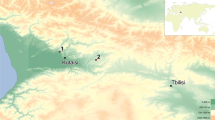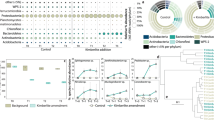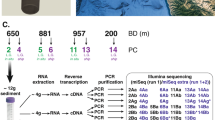Abstract
During the last decade, sensitive techniques for detecting DNA have been successfully applied to archaeological and other samples that were a few hundred to a few thousand years old1,2. Nevertheless, there is still controversy and doubt over claims of exceptionally ancient DNA3. Additional accounts stretching back nearly a century suggest that microorganisms may survive over geological time in evaporite deposits4,5. There is, however, often doubt over the age relationship between evaporite formation and the incorporation of microorganisms6. Here, we have used petrographic and geochemical techniques (laser ablation microprobe–inductively coupled plasma–mass spectrometry) to verify the estimated geological age of halite (NaCl) evaporite samples. Fragments of 16S ribosomal RNA genes were detected by polymerase chain reaction amplification of DNA extracted from halite samples ranging in age from 11 to 425 Myr (millions of years). Haloarchaeal 16S rDNA amplicons were present in one sample (11–16 Myr), whereas other samples (65–425 Myr) yielded only bacterial 16S rDNA amplicons. Terminal restriction fragment length polymorphism analyses indicate complex and different populations of microorganisms or their free DNA in ancient halites of different ages.
This is a preview of subscription content, access via your institution
Access options
Subscribe to this journal
Receive 51 print issues and online access
$199.00 per year
only $3.90 per issue
Buy this article
- Purchase on Springer Link
- Instant access to full article PDF
Prices may be subject to local taxes which are calculated during checkout




Similar content being viewed by others
References
Woodward, S. R., Weyand, N. J. & Bunnell, M. DNA sequence from Cretaceous period bone fragments. Science 266, 1229–1232 (1994)
Cano, R., Poinar, H. N. & Poinar, G. O. Isolation and partial characterisation of DNA from the bee Proplebeia dominicans (Apidae: Hymenoptera) in 25–40 million year old Dominican amber. Med. Sci. Res. 20, 249–251 (1992)
Smith, A. & Austin, J. J. Can geologically ancient DNA be recovered from the fossil record? Geoscientist 7, 8–11 (1998)
McGenity, T. J., Gemmell, R. T., Grant, W. D. & Stan-Lotter, H. Origins of halophilic microorganisms in ancient salt deposits. Environ. Microbiol. 2, 243–250 (2000)
Vreeland, R. H., Rosenzweig, W. D. & Powers, D. W. Isolation of a 250 million year old halotolerant bacterium from a primary salt crystal. Nature 407, 897–899 (2000)
Hazen, R. M. & Roedder, E. How old are bacteria from the Permian age? Nature 411, 155 (2001)
Norton, C. F. & Grant, W. D. Survival of halobacteria within fluid inclusions in salt crystals. J. Gen. Microbiol. 134, 1365–1373 (1988)
Gemmell, R. T., McGenity, T. J. & Grant, W. D. Use of molecular techniques to investigate possible long term dormancy of halobacteria in ancient salt deposits. Ancient Biomol. 2, 125–133 (1998)
Wardlow, N. C. & Schwerdtner, W. M. Halite-anhydrite seasonal layers in the Middle Devonian Prairie Formation, Saskatchewan, Canada. Geol. Soc. Am. Bull. 77, 331–342 (1966)
Roedder, E. The fluids in salt. Am. Mineral. 69, 413–439 (1984)
Shepherd, T. J., Ayora, C., Cendón, D. I., Chenery, S. R. & Moissette, A. Quantitative solute analysis of single fluid inclusions in halite by LA-ICP-MS and cryo-SEM-EDS: complementary microbeam techniques. J. Eur. Mineral. 10, 1097–1108 (1998)
Gunther, D., Audetat, A., Frischknecht, R. & Heinrich, C. A. Quantitative analysis of major, minor and trace elements in fluid inclusions using laser ablation-inductively coupled plasma mass spectrometry (LA-ICP-MS). J. Anal. At. Spectrom. 13, 263–270 (1998)
Timofeeff, M. N., Lowenstein, T. K. & Hardie, L. A. in Ninth Ann. V.M. Goldschmidt Conf. 299 (abstract) (Lunar and Planetary Institute, Houston, 1999)
Hardie, L. A. Evaporites, marine or non-marine? Am. J. Sci. 284, 193–240 (1984)
Hardie, L. A. Secular variations in seawater chemistry: an explanation for the coupled secular variation in the mineralogies of marine limestone and potash evaporites over the past 600 my. Geology 24, 279–283 (1996)
Zimmermann, H. On the origin of fluids included in Phanerozoic marine halite; basic interpretation strategies. Geochim. Cosmochim. Acta 65, 35–45 (2001)
Timofeeff, M. N., Lowenstein, T. K. & Blackburn, W. H. ESEM-EDS. An improved technique for major element chemical analysis of fluid inclusions. Chem. Geol. 164, 171–182 (2000)
Timofeeff, M. N. et al. Evaluating seawater chemistry from fluid inclusions in halite: examples from modern marine and non-marine environments. Geochim. Cosmochim. Acta 65, 2293–2300 (2001)
Rosler, H. J. & Lange, H. Geochemical Tables—Table 97: Composition of sea water (Elsevier, Amsterdam/London/New York, 1972)
Sommers, R. & Tautz, D. Minimal homology requirements for PCR primers. Nucleic Acids Res. 17, 674 (1989)
Rychlik, W. Priming efficiency in PCR. Biotechniques 18, 84–89 (1995)
Rychlik, W., Spencer, W. J. & Rhoads, R. E. Optimization of the annealing temperature for DNA amplification in vitro. Nucleic Acids Res. 18, 6409–6412 (1990)
Kalmbach, S., Manz, W., Wecke, J. & Szewzyk, U. Aquabacterium gen. nov., with description of Aquabacterium citratiphilum sp. nov., Aquabacterium parvum sp. nov., and Aquabacterium commune sp. nov., three in situ dominant bacterial species from the Berlin drinking water system. Int. J. Syst. Bacteriol. 49, 769–777 (1999)
Müller, A. & Schwartz, W. Über das Vorkommen von Mikroorganismen in Salzlagerstätten (geomikrobiologische Untersuchungen III). Zeitschrift Deutschen Geologischen Gesellschaft 105, 789–802 (1953)
Norton, C. F., McGenity, T. J. & Grant, W. D. Archaeal halophiles (halobacteria) from two British salt mines. J. Gen. Microbiol. 139, 1077–1081 (1993)
Grant, W. D., Gemmell, R. T. & McGenity, T. J. Halobacteria: the evidence for longevity. Extremophiles 2, 279–287 (1998)
Höss, M. & Pääbo, S. DNA extraction from Pleistocene bones by a silica-based purification method. Nucleic Acids Res. 21, 3913–3914 (1993)
Jukes, T. H. & Cantor, C. R. in Mammalian Protein Metabolism (ed. Munro, H. N.) Vol. 3, 21–132 (Academic, New York, 1969)
Saitou, N. & Nei, M. The neighbour-joining method: a new approach for constructing phylogenetic trees. Mol. Biol. Evol. 4, 406–425 (1987)
Acknowledgements
The samples were provided by M. N. Timofeef, S. Brennan and T. K. Lowenstein, and we acknowledge their contribution to the research. We also thank D. Gunther and B. Hattendorf for undertaking corroborative chemical analysis of the brine inclusions. This work was supported by an NERC grant.
Author information
Authors and Affiliations
Corresponding author
Ethics declarations
Competing interests
The authors declare that they have no competing financial interests.
Rights and permissions
About this article
Cite this article
Fish, S., Shepherd, T., McGenity, T. et al. Recovery of 16S ribosomal RNA gene fragments from ancient halite. Nature 417, 432–436 (2002). https://doi.org/10.1038/417432a
Received:
Accepted:
Issue Date:
DOI: https://doi.org/10.1038/417432a
This article is cited by
-
Peopling of India: Ancient DNA perspectives
Journal of Biosciences (2019)
-
Geomorphologic Characteristics of Polygonal Features on Chloride-Bearing Deposits on Mars: Implications for Martian Hydrology and Astrobiology
Journal of Earth Science (2019)
-
Life on the edge: active microbial communities in the Kryos MgCl2-brine basin at very low water activity
The ISME Journal (2018)
-
Dynamics and distribution of bacterial and archaeal communities in oil-contaminated temperate coastal mudflat mesocosms
Environmental Science and Pollution Research (2015)
-
A newly isolated Haloalkaliphilic bacterium from middle–late Eocene halite formed in salt lakes in China
Carbonates and Evaporites (2015)
Comments
By submitting a comment you agree to abide by our Terms and Community Guidelines. If you find something abusive or that does not comply with our terms or guidelines please flag it as inappropriate.



